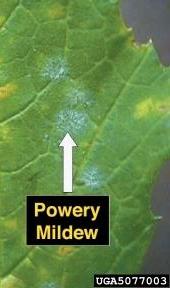 Managing Powdery Mildew - July 4, 2012 Jeff Schalau, Agent, Agriculture & Natural Resources University of Arizona Cooperative Extension, Yavapai County Powdery mildew often appears on vegetable, ornamentals, and fruit trees during the summer months. In the vegetable garden, it often appears on the leaves of cucurbits (squash, cucumbers, and melons). In the landscape, it commonly infects Euonymus (and evergreen shrub) and roses. Powdery mildew is caused by a fungus that forms white powdery patches on leaves, stems, or fruits. The powdery material is actually a mass of fungal strands (called mycelium), which may also contain spores (reproductive structures). Once this disease appears, it is very difficult to control. There are several species of fungi that cause powdery mildew and each species has a set of closely related host plants they infect. For example, the type of powdery mildew that infects roses will not infect cucurbits and vice versa. Some plant species tend to be infected by powdery mildew when they are not well suited to the environment in which they are planted. For example, Euonymus planted in a shady location may be more susceptible to powdery mildew than one planted in full sun. Conversely, cucurbits seem to get powdery mildew toward the end of the growing season regardless of planting site and cultural practices. Powdery mildew initially infects host plants when a spore lands on the leaf surface. The spore germinates and develops a mycelium that spreads over the plant. On leaves, it most often grows on the upper surfaces. The fungus nourishes itself by penetrating into plant cells with root-like structures called haustoria, which remove mineral nutrients, sugars, and other compounds. On annuals and shrubs, the disease infects older leaves first. During heavy infections, these leaves often turn brown and die. Powdery mildew is most likely to infect plants during periods of moderate to high humidity and temperatures. Good air circulation is beneficial but does not prevent infection. Spores germinate on dry plant surfaces. Water on leaf surfaces actually inhibits spore germination. Powdery mildew resistant varieties of some plants are now available. Read seed packets and plant descriptions to identify these varieties. Cultural practices can also be used to minimize powdery mildew damage. Some of these are planting on full sun, avoiding areas with poor air movement, avoiding overcrowding of plantings, and using overhead irrigation to prevent spore germination. Several compounds/chemicals can be applied to minimize damage from powdery mildew. All of these are most effective if applied when the very first signs of infection appear. Sulfur has been used for centuries to control powdery mildew. However, be aware that sulfur can damage some crops, especially if temperatures are above 90 degrees F. Overhead sprinkling may help reduce powdery mildew because spores are washed off the plant. Another least toxic method of powdery mildew control is using baking soda. One formulation that I have seen is 1 tsp baking soda, one quart of water, and a few drops of liquid soap. Commercially produced, synthetic fungicides that control powdery mildew are also available. As with any pesticide, read the label carefully and follow directions explicitly. These products will list crops that are approved for application, mixing instructions, personal protection needed, and other important information that allow you to safely use these products. Some of these are Bayleton (triadimefon), Rally (mycobutanil), Rubigan (fenarimol), and Funginex (triforine). Biological controls are also available. One product is called AQ10. It is a fungus (Amplomyces quisqualis) that attacks powdery mildew fungus. The spores germinate and grow into powdery mildew mycelia and the AQ10 parasitizes powdery mildew. Neem oil, while usually used as a botanical insecticide, is also effective at controlling powdery mildew. The oil is extracted from the depulped seeds of the neem tree: a native to the Indian subcontinent. Naming of companies or products is neither meant to imply endorsement by the author nor criticism of similar companies or products not mentioned. Follow the Backyard Gardener on Twitter – use the link on the BYG website. If you have other gardening questions, call the Master Gardener help line in the Camp Verde office at 928-554-8999 Ext. 3 or e-mail us at cottonwoodmg@yahoo.com and be sure to include your name, address and phone number. Find past Backyard Gardener columns or provide feedback at the Backyard Gardener web site: http://cals.arizona.edu/yavapai/anr/hort/byg/. |